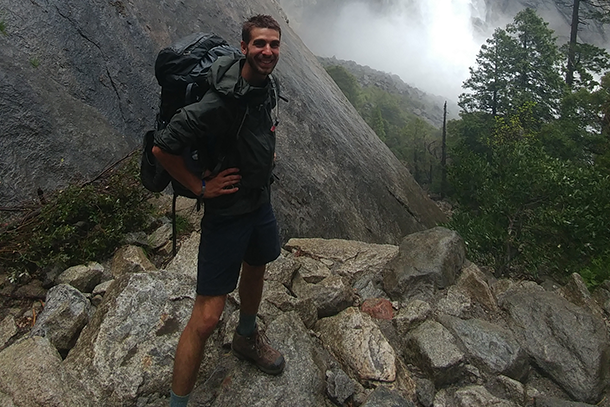
Samuel Lapp, engineering design alumnus, combines his passion for sustainability and nature in his engineering design work. This past summer, he spent a month living in Yosemite National Park working as a part of the Leave No Trace Center for Outdoor Ethics.
Alumnus' interests combine at engineering design intersection point
Samuel Lapp speaks to his work in nature, sustainable engineering and product creation
10/25/19
By Cassie Kidwell
UNIVERSITY PARK, Pa. — Samuel Lapp has included sustainable engineering as a common thread in his post-graduate work—initially as a field researcher for Leave No Trace Center for Outdoor Ethics, an organization that provides research, education and initiatives to help care for the outdoors.
After receiving his master of science in engineering design (DESIGN) in 2019, Lapp began his sustainability work with the organization, completing research under its Zero Landfill initiative.
Spending one month each living in three national parks—Yosemite, Denali and Grand Teton—Lapp investigated visitors’ recycling behavior to find out whether they were reading signs and recycling correctly. Surveying the recycling efforts allowed researchers to determine whether or not the placed signs made a difference in visitor behavior.
Recently, he became involved with Doors Unhinged, a Pittsburgh-based company that sources and distributes lightly used commercial door systems. The waste-reducing initiative was introduced to Lapp by the company’s CEO, Andrew Ellesworth, when they both attended Penn State’s recent sustainability conference, Research to Action: The Science of Drawdown.
Lapp sees his sustainability and nature interests and engineering skills coming together at an engineering design junction point, including his upcoming work gathering bird acoustics data with Justin Kitzes, an assistant professor in spatial macroecology at the University of Pittsburgh.
Kitzes studies conservation biology in his lab, The Kitzes Lab. There he measures populations to better understand what causes biodiversity loss and extinction, ultimately trying to prevent them. Lapp will measure bird and bat diversity and abundance by placing multiple microphones throughout the forest to capture their sounds.
“This project is really exciting because it plays at the intersection of engineering, nature, conservation and of my interest of acoustics,” he said.
As a DESIGN graduate student, Lapp attended Design Thinking Week, a week-long design thinking workshop held in Berlin, Germany. There, he applied engineering design skills he learned during his masters program to complete work, instead of simply theorizing designs. Engineers and engineering faculty members from around the world were there to help and promote excitement about engineering design.
Also during his time in Berlin, Lapp was able to meet with fellow Amparo project members. Based in Berlin, Amparo is a startup company that creates prosthetic solutions for below-the-knee amputees. As part of Global Engineering Teams, Lapp began working on a team of designers prototyping these prosthetics. By traveling to Berlin, Lapp was able to meet fellow team members to collaborate in person.
For Lapp, one of the best experiences during his engineering design masters program was his time during the two design studio courses, which provide engineering design students with the opportunity to design and complete real projects. Lapp and his group designed, prototyped and tested a device that measures properties of a person’s step while walking with a prosthetic foot, giving direct feedback for a prosthetist to make the correct adjustments.
Lapp called the design and product creation process executed in the courses the “cornerstone of the program,” because they provide students with the ability to complete various projects for experience and resume building.
He compared the graduate design studio courses to the first-year engineering design course EDSGN 100: Cornerstone Engineering Design, as all three are open-ended, project-based courses.
“I remember as a freshman at Penn State really loving EDSGN 100 and hoping that’s what my engineering education and career would be like,” Lapp said. “When you go through engineering school, a lot of it isn’t like that, with technical classes, so it was really exciting to get back into an environment like that.”
The flexibility of the DESIGN program appealed to Lapp’s interest areas. Being able to tailor his degree by enrolling in courses from across the University allowed him to experience in other disciplines offered by Penn State.
Lapp said another significant piece of his masters program was his thesis, a year-long research project focused on simulating the ways in which people solve problems, or their cognitive style, in teams. To simulate the model, he designed KABOOM (KAI Agent-Based Organizational Optimization Model) to investigate the effects of a design team’s communication patterns, specialization and cognitive style composition have on a team’s performance.
This application of engineering design elements learned in the DESIGN program can also be seen in Lapp’s independently launched product, an evolution card game called Darwin. Available online and at various locations in State College and Pittsburgh, Lapp applied his learned cycle of design and production to launch a full-scale product to the market. The game allows players to create a species, compete for resources and adapt to survive by learning evolutionary traits and survival techniques.
“[Creating Darwin] was exactly the process taught in the DESIGN program—understanding the audience, facing challenges, creating the prototype and marketing,” he said.


